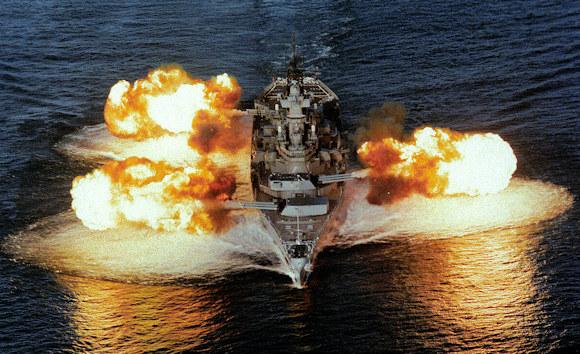Built as part of the 1939 naval programs (BB 61 Iowa and BB 62 New Jersey) and the 1941 (BB 63 Missouri and BB 64 Wisconsin), the Iowa they originally had a displacement of 45.870 tons (full load 56.300), an overall length of 270 meters, a width of 33 meters and a rigging consisting of 9 406 / 50 mm guns in three tri-tower towers, 10 twin-tower turrets from 127 / 38 mm and 20 anti-aircraft complexes with 40 mm squares, plus 50 machine-gunner with 20 mm.
The propulsion apparatus was able to supply a power equal to 212.000 cv, which allowed to have a maximum speed of 32 nodes and a range of 11.000 miles. the protection reached a maximum thickness of 305 mm at the waterline, 440 mm at the bore of the large caliber towers and at the keep, 127 mm at the armored bridge and 430 mm at the large caliber towers.
Participation in the Second World War took place mainly in the Pacific, both in support of the incursions of fast aircraft carriers and with interventions in focus against land targets, both on the islands occupied by Japanese forces and against the Japanese archipelago.
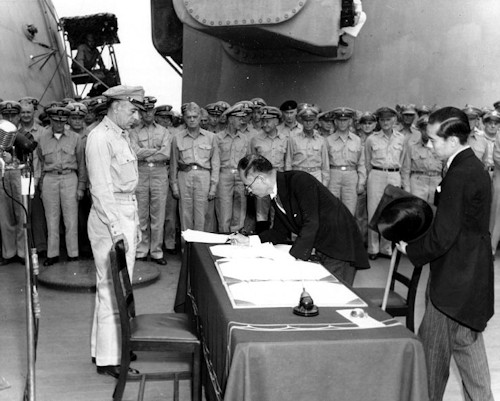
The 2 September 1945, on the bridge of the Missouri, the official ceremony of the unconditional surrender of Japan took place, notified by Foreign Minister Mamoru Shigemitsu to General MacArthur.
Between the 1948 and the 1949 three of the Iowa are placed in reserve, while the Missouri, after returning to the United States and having undergone a brief revision at the arsenal of New York, played a diplomatic role in the post-World War II years, showing a flag in the Mediterranean in support of Turkey during the crisis with the USSR of the 1946, and in the South Atlantic for the signing of the Rio de Janeiro Treaty of September 1947.
The 19 August 1950 the Missouri heads to south-east Asia, where the 15 September its 406 mm pieces come into action to support the landing of the Marines in Inchon. Returns from Korea in the April of 1953 and less than two years later, the 26 February 1955, is placed in reserve.
Also the other three units of the class Iowa participated in the Korean conflict, bombarding coastal targets and communist positions (cave artillery batteries, ammunition dumps, troop concentrations, communications lines), making the most of the range of 406 mm pieces (New Jersey was able to shoot, in the nine months of employment in the conflict, over 7.000 blows). With the armistice of the 27 in July 1953 ends the participation of the battleships in the Korean conflict and they return to the United States where in the 1956 the three still in service are modified for the transport and use of nuclear ammunition, consisting of 406 mm Mk- projectiles 23. In the 1958 all four are put back in reserve.
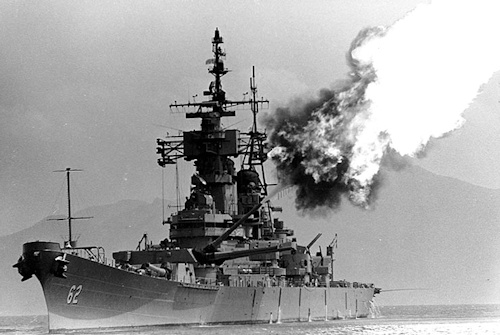
The first battleship to emerge from hibernation was, the 6 April 1968, the New Jersey. Requested loudly by the Marines since the 1964, in order to have a more effective support of fire with the intensification of operations in Vietnam. The reactivation of the battleship was strongly opposed by the Chief of Naval Operations (CNO) of the US Navy, Admiral David MacDonald, so much so that the final decision was taken only in August of 1967 with the advent of a new CNO.
The choice fell on New Jersey as you know it was in better condition than the other three. At the end of 10 months of work returned to being part of the active fleet. The changes involved the removal of pieces from 40 mm, the installation of two ballistic calculators, a designation system for 406 mm batteries and new telecommunications equipment, the creation of an area for helicopter assembly aft and the introduction of an ECM system designed to combat any attacks carried out with Soviet SS-N-2 anti-ship missiles Styx.
The 25 September of the 1968 New Jersey is off the coast of Vietnam, however it did not remain in service for long. In June of the 1969 the new Secretary of Defense Melvin Laird began to consider its withdrawal, which was announced the following 22 August. The 17 December 1969 the flag was lowered.
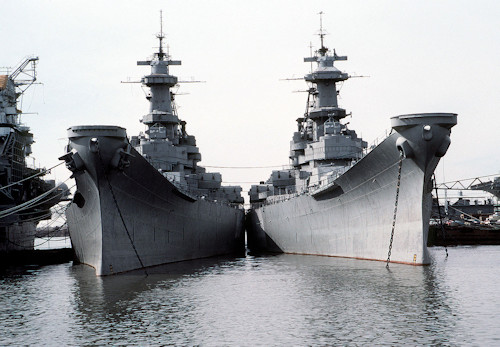 In the 70 years the Pentagon begins to consider proposals to reactivate one or more battleships, evaluating hypotheses of modernization and modifications, from the strengthening of self-defense capabilities to offensive ones and fire support through the adoption of guided long-range bullets, missiles cruisers and aircrafts embarked vertically, with estimated costs above 200 million.
In the 70 years the Pentagon begins to consider proposals to reactivate one or more battleships, evaluating hypotheses of modernization and modifications, from the strengthening of self-defense capabilities to offensive ones and fire support through the adoption of guided long-range bullets, missiles cruisers and aircrafts embarked vertically, with estimated costs above 200 million.
Under the decisive thrust exerted once again by the Marine Corps - determined to obtain greater fire support in the potential crises that threatened to involve the United States - the time of the return of the battleships was certainly not far off. In the 1981, with the advent of the Reagan Administration, the project was fished out and included in the supplementary budget for the fiscal year 1981; in the 1982 the funds for theIowa (in the photo, on the right) and in the 1984 those for the Wisconsin (in the photo, left), while the return to the line of Missouri it was financed with funds recovered from savings in expenses realized in the 1981-84.
Among the tasks that the US Navy intended to assign to battleships Iowa the execution of offensive operations, within aircraft carrier groups in areas of high threat level, the conduct of independent operations, with the support of an appropriate escort, in areas of lower risk, the support of amphibious operations, the attack of surface and land naval targets and the supply of naval units and helicopters.
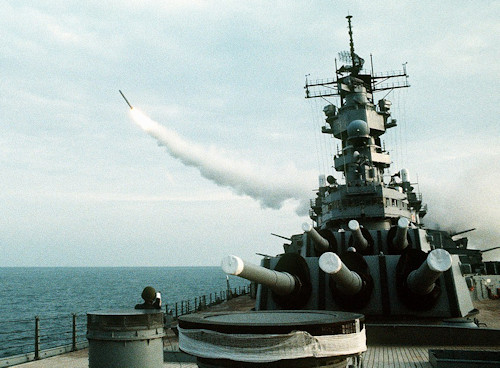 The modernization works involved the unloading of 4 systems combined by 127 / 38 mm to make room for 8 quadrilateral launchers for cruise missiles Tomahawk, both in the version for attack to terrestrial targets and naval targets; installation of 4 quadrilateral launchers for anti-ship missiles Harpoon; of 4 CIWS Vulcan Phalanx systems for point defense; of an ECM AN / SLQ-32 system; of new radars of air discovery (AN / SPS-49) and surface (AN / SPS-67). The 406 mm pieces kept the same ammunition as the Second World War: old armor-piercing bullets Mk-8 and HE Mk-13.
The modernization works involved the unloading of 4 systems combined by 127 / 38 mm to make room for 8 quadrilateral launchers for cruise missiles Tomahawk, both in the version for attack to terrestrial targets and naval targets; installation of 4 quadrilateral launchers for anti-ship missiles Harpoon; of 4 CIWS Vulcan Phalanx systems for point defense; of an ECM AN / SLQ-32 system; of new radars of air discovery (AN / SPS-49) and surface (AN / SPS-67). The 406 mm pieces kept the same ammunition as the Second World War: old armor-piercing bullets Mk-8 and HE Mk-13.
The first battleship to re-enter was the New Jersey, the 28 December 1982; followed the Iowa (28 April 1984), the Missouri (15 May 1986) and the Wisconsin (22 October 1988).
The first unit to return to action was once again the New Jersey, which in the 1983-84 was deployed off the Lebanese coasts, in the most acute phase of the civil war in the country.
The 14 December 1983 the battleship fired 11 bullets from 406 mm against Syrian anti-aircraft positions in the outback of Beirut, which a few days earlier had shot down two A-6 Intruder of the Navy. Other 300 shots were fired at the beginning of February of the 1984 against Syrian and Druze positions in the Bekaa valley.
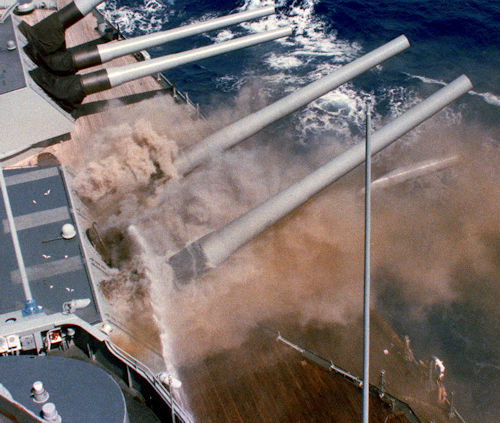 The 19 April 1989 there was a serious accident aboard the Iowa, engaged in an exercise in fire in the Caribbean. An explosion occurred in the tower number 2 killed 47 sailors and knocked out the plant, which was no longer repaired.
The 19 April 1989 there was a serious accident aboard the Iowa, engaged in an exercise in fire in the Caribbean. An explosion occurred in the tower number 2 killed 47 sailors and knocked out the plant, which was no longer repaired.
Iowa e New Jersey the 26 OCTOBER 1990 and the 8 February 1991 were respectively decommissioned, without re-entering into action, an occasion which instead presented itself at Missouri and Wisconsin, sent to the Persian Gulf following the invasion of Kuwait by Saddam Hussein.
La Missouri arrived in the area of operations in the early days of the 1991 and the January 17 participated in the launch of missiles Tomahawk against Iraqi targets. During the conflict, BB 63 launched 28 missiles throughout and invested with 406 mm guns, altering with the twin Wisconsin, enemy targets on the island of Faylaka and near Kuwait City. Returning to the United States at the end of the conflict, the Missouri the 31 March 1992 in Long Beach, the last battleship to leave active duty, was dismissed.
It had preceded it by a few months, the 30 September 1991, the BB 64 Wisconsin: the cuts to the defense budget and the high costs of managing the battleships - characterized by a crew too numerous in relation to the capacity to express, marked the final departure from the scene.
Photo: US Navy

